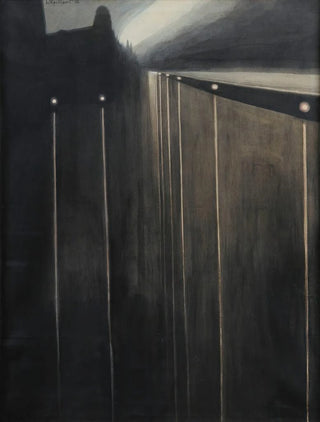Art print | Ostend Dike with Street Lamps - Léon Spilliaert Source: Reproduction | Digue d'Ostende aux réverbères - Léon Spilliaert


View from behind

Frame (optional)
Digue d'Ostende with streetlights - Léon Spilliaert – Captivating introduction
In the fascinating universe of art, some works manage to capture the very essence of a moment, to freeze the atmosphere of a place with such intensity that they transcend the simple frame of painting. "Digue d'Ostende with streetlights" by Léon Spilliaert is undoubtedly one of these creations. This painting, imbued with palpable melancholy, evokes the austere beauty of Belgian landscapes, where the sea and sky meet in a delicate dance. The light, subtly orchestrated by the artist, seems to play with shadows, creating an ambiance that is both mysterious and captivating. Through this work, the viewer is invited to dive into a world where dream and reality blend, where each streetlight becomes a lighthouse guiding lost souls in the night.
Style and uniqueness of the work
Spilliaert's work is distinguished by its unique style, marked by bold use of colors and shapes. In "Digue d'Ostende with streetlights," the choice of palette evokes a nocturnal atmosphere, where shades of blue and black blend with touches of golden light. The streetlights, central figures of the composition, are depicted in an almost ghostly manner, their glow contrasting with the surrounding darkness. This duality between light and shadow creates a visual tension that captivates the eye. Moreover, the treatment of lines and shapes demonstrates a particular sensitivity to space, where each element seems to breathe and dialogue with its environment. Spilliaert thus manages to infuse a poetic dimension into his work, transforming a simple landscape into a true emotional experience.
The artist and his influence
Léon Spilliaert, an emblematic figure of Belgian art, has established himself through his singular vision and innovative approach. Raised in the artistic atmosphere of the late 19th and early 20th centuries, he was influenced by symbolism and impressionism, while developing a personal style that is uniquely his own. His work, often introspective, explores themes such as solitude, melancholy,

Matte finish

View from behind

Frame (optional)
Digue d'Ostende with streetlights - Léon Spilliaert – Captivating introduction
In the fascinating universe of art, some works manage to capture the very essence of a moment, to freeze the atmosphere of a place with such intensity that they transcend the simple frame of painting. "Digue d'Ostende with streetlights" by Léon Spilliaert is undoubtedly one of these creations. This painting, imbued with palpable melancholy, evokes the austere beauty of Belgian landscapes, where the sea and sky meet in a delicate dance. The light, subtly orchestrated by the artist, seems to play with shadows, creating an ambiance that is both mysterious and captivating. Through this work, the viewer is invited to dive into a world where dream and reality blend, where each streetlight becomes a lighthouse guiding lost souls in the night.
Style and uniqueness of the work
Spilliaert's work is distinguished by its unique style, marked by bold use of colors and shapes. In "Digue d'Ostende with streetlights," the choice of palette evokes a nocturnal atmosphere, where shades of blue and black blend with touches of golden light. The streetlights, central figures of the composition, are depicted in an almost ghostly manner, their glow contrasting with the surrounding darkness. This duality between light and shadow creates a visual tension that captivates the eye. Moreover, the treatment of lines and shapes demonstrates a particular sensitivity to space, where each element seems to breathe and dialogue with its environment. Spilliaert thus manages to infuse a poetic dimension into his work, transforming a simple landscape into a true emotional experience.
The artist and his influence
Léon Spilliaert, an emblematic figure of Belgian art, has established himself through his singular vision and innovative approach. Raised in the artistic atmosphere of the late 19th and early 20th centuries, he was influenced by symbolism and impressionism, while developing a personal style that is uniquely his own. His work, often introspective, explores themes such as solitude, melancholy,






